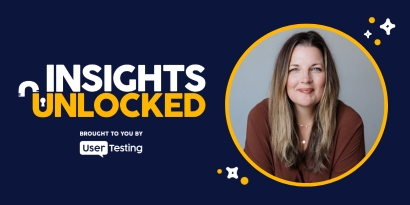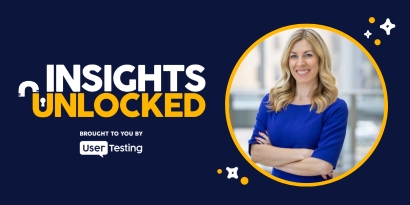
Episode 166 | April 14, 2025
Customer journey mapping and storytelling at G2
Dane Howard shares how G2 used storytelling and customer journey mapping to drive design innovation and cross-team alignment.
How customer journey mapping and storytelling unlock innovation at G2
What do Disneyland, city maps, and design leadership have in common? According to Dane Howard, VP of Product Design at G2, they’re all powerful metaphors for one of the most transformative tools in a customer-centric organization: the customer journey map.
In a recent episode of Insights Unlocked, Dane shared how storytelling in design, visual journey maps, and purposeful leadership are fueling innovation and alignment at G2. Whether you’re leading UX strategy, product design, or internal transformation, this conversation is packed with actionable ideas for crafting experiences that resonate—both inside and outside your organization.
ON-DEMAND WEBINAR
Building high performance design teams that drive goal conversion rates
In this webinar, we’ll cover:
- Structuring a high-impact team
- Embedding customer insights at scale
- Building a customer-driven culture for impact
The magic of metaphor: Why journey mapping matters
For many companies, the idea of customer journey mapping sounds like a tactical exercise. But Dane and his team took it several steps further—transforming it into a central artifact that aligns product, marketing, engineering, and leadership around a shared vision.
“In onboarding, I started hearing stories that were powerful—but disconnected,” Dane explained. “So I asked, ‘What if we created a visual map that made the whole experience feel like a place?’”
Inspired by a Disneyland park map, G2’s journey map isn’t just another flowchart. It’s an imaginative, visual representation of how customers interact with the platform—complete with towers, concierge desks, and a data lake you can water ski on.
“There’s just enough detail that you could give it to someone who's been there 100 times, or someone who's never been there, and they can still find their way.” – Dane Howard
By leaning into storytelling in design, Dane’s team created something more than an artifact—they built a metaphorical city that people at G2 could explore, contribute to, and use to orient their work around the customer.
Aligning teams through design thinking and storytelling
In fast-growing companies, cross-functional alignment is one of the biggest challenges. Dane’s journey map became a tool to foster that alignment by giving every team a recognizable “location” within the experience.
From legal to integrations, internal teams began to find themselves in the map. The integrations team even adopted the role of “concierge,” helping users navigate between tools—turning an abstract function into a tangible, high-impact role.
“The customer doesn’t care how you’re organized internally. They just care about the experience. So the map helps connect the dots for everyone.” – Dane Howard
This approach to customer experience strategy not only helped G2 visualize their product ecosystem—it broke down silos and made it easier for teams to see how their work contributes to the overall experience.
Here’s how Dane recommends keeping an artifact like this alive and relevant:
- Embed it in onboarding for new employees
- Print and display it across offices to keep it top of mind
- Use it as a backdrop during cross-functional workshops
- Reserve budget and time for regular updates and improvements
Bringing design leadership into internal communication
Dane emphasized a critical shift in how design leaders should think about their work: the power of internal storytelling.
“I’ve seen so many great artifacts die because they weren’t communicated well,” he said. “So now, before we build anything, I start writing the story of how it will be used, who will see it, and what conversations it will spark.”
This storytelling-first mindset helps ensure that design artifacts like customer journey maps become tools for engagement—not just documentation.
“Software is still predominantly a human-led act of will. If you can’t get everyone on the same page with a clear story, it doesn’t matter how good the design is.”
To make this tangible, Dane shared how G2 begins each year with a “Sprint Zero”—a collection of visual prototypes and mini-films that bring their annual strategy to life. It’s a script for the year, told through visuals and storytelling, to help everyone—from designers to execs—understand where they’re headed.
The three-legged stool: balancing purpose, career, and creativity
Another powerful theme in the episode is Dane’s philosophy of purpose-driven design.
Beyond his work at G2, Dane contributes to advocacy and mentorship initiatives through his personal studio. He describes his life as a “three-legged stool” balanced between:
- Full-time leadership at G2
- Coaching and advisory roles
- Passion projects like Sam, Beautiful and Black Players for Change
This balance doesn’t just keep him inspired—it directly informs his product design leadership.
“When I’m engaged in meaningful work outside of my day job, I come back sharper, more empathetic, and more creative,” Dane said. “It’s all connected.”
He encourages other design and UX professionals to pursue personal projects and advocacy that align with their values, not just their careers.
“Software is an act of will. When people believe they can make change, that belief becomes a force multiplier.”
GUIDE
Keys to impactful designs that drive goal conversion rates
This guide explores how design leaders can strategically optimize goal conversion rates by predicting the impact of design choices before development begins and benchmarking conversion rate success over time.
Leading with empathy and customer experience—not just design
One of the most compelling ideas Dane shared is the importance of reframing design work through the lens of customer experience.
“I used to speak the language of design. But over time, I’ve learned that when I speak in terms of customer experience and business outcomes, people listen differently,” he said.
For leaders in UX research, product design, or CX, this is a valuable insight. It’s not about watering down your expertise—it’s about making your impact more accessible and resonant across teams.
When internal stakeholders see how a design decision improves customer satisfaction or drives business results, it becomes easier to build buy-in and momentum.
How storytelling builds culture and momentum
Throughout the episode, Dane returns to the idea that storytelling isn’t just for users—it’s for internal teams, too.
By using metaphors, narratives, and visuals, you can:
- Help employees understand the big picture
- Make strategy feel more human and less abstract
- Create a shared language for collaboration
- Turn planning into something inspiring, not just procedural
One example? When introducing new initiatives, Dane often uses a “future headline” format inspired by Amazon’s PR/FAQ approach. This helps teams imagine the impact before the work even begins.
“Design leadership today is as much about communication as it is about craft.”
What your company can learn from G2’s approach
If you’re considering building or updating your own customer journey map—or any cross-functional initiative—Dane’s experience at G2 offers several key takeaways:
- Use storytelling to make the abstract tangible. Metaphors like cities, parks, and scripts can bring clarity to complex systems.
- Design for internal audiences too. Think about how artifacts will be used, not just what they look like.
- Reframe design as experience. Speak in terms of outcomes and empathy to connect with a broader audience.
- Balance purpose with leadership. Personal growth fuels professional impact.
- Keep your artifacts alive. Update them regularly and integrate them into everyday processes.
Embracing curiosity and creative confidence
As organizations evolve, the most effective leaders are the ones who can connect vision to execution—and do it in a way that brings others along.
That’s why Dane Howard’s insights on journey mapping, storytelling, and purpose-driven leadership are so timely. They remind us that while technology moves fast, the human side of design still matters most.
We’ll leave you with a quote that sums it all up:
“This is a really interesting time historically to be building things. I just enjoy that—and I’m ready for my third, fourth wind to see what we can make together.” – Dane Howard
Episode links:
- Connect with Dane Howard on LinkedIn
- Connect with Jason Giles on LinkedIn
- G2.com
- danehoward.com
- Dane’s LinkedIn article on G2’s Customer Journey Mapping project
- How to create customer journey maps to increase conversions: This blog post explores the importance of customer journey mapping and provides a step-by-step guide to creating effective journey maps that enhance customer experiences and boost conversions.
- How storytelling can drive customer-centricity and inspire action: This on-demand webinar discusses leveraging storytelling when sharing customer insights to capture stakeholders’ attention and inspire meaningful action.
- Design leadership & UX strategy with John S. Couch: In this podcast episode, John S. Couch, former VP of Product Design at Hulu, shares insights on transforming UX strategy through design leadership, vision, and user research.









